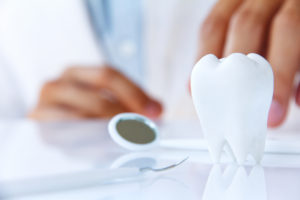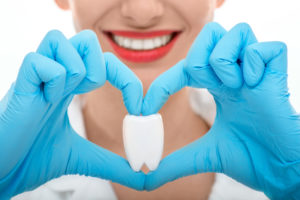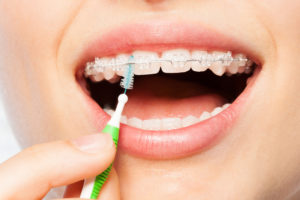Building Strong Teeth for Life

Many people take vitamins, exercise and eat right to maintain a healthy body. However, what about your teeth? They need tender loving care to stay healthy and strong as well. Most people either don’t realize how much care they need to give their teeth, or they forget because of busy schedules. However, building strong teeth for life only takes a few minutes of your day to achieve. Your teeth need daily brushing, flossing and other care to keep them free of damaging substances. You also need dental appointments, oral cancer screenings, a healthy diet and more to avoid tooth loss and oral health problems. Follow these simple guidelines to keep your smile healthy for life!
How Strong Are Teeth?
Many people simply assume that the teeth are bones, but they actually are not. Your bones and your teeth are some of the hardest tissues in your body and are made of calcium and phosphate. However, your teeth are actually harder. Bones have spongy insides, but teeth are 96% hard mineral. That’s why you can exert up to 200 pounds of pressure when you chew according to the ADA. However, no matter how strong teeth are, they can’t repair themselves when they become damaged.
What Weakens Teeth
Your teeth are some of the strongest parts of your body, but even the strongest materials can become weak over time. Generally, poor oral hygiene habits are what weaken your teeth the most. Genetics can give some patients weak enamel, but 99% of the time the problem is your hygiene. Tooth decay is so common among American children and adults, that the National Institutes of Health consider it to be the most “prevalent chronic disease” around. You get this disease by simply not brushing and flossing enough. Sugar plus saliva makes plaque, and that plaque sticks to your teeth and decays them. People who don’t brush or floss their teeth can expect to have problems with tooth decay, bad breath, gum disease, tooth loss and more. Bottom line: brush your teeth and do it every day!

Building Strong Teeth Through Nutrition
Too often, the American diet consists of quick foods that generally are low in nutrition and high in sugar. If you look at the labels of most of these foods, you will find that ½ or more of many pre-packaged snacks are pure sugar. Even “healthy” or diet foods can be terrible for both your body and your teeth because of that sugar factor. Foods that have an unexpectedly high amount of sugar include:
- Yogurt
- Breads (rolls, pastries, doughnuts, sandwich bread, etc.)
- Cereal (including oatmeal)
- Drinks
- Protein bars
- Pancakes and similar breakfast items
- Many dressings and sauces
- Fruit snacks or dried fruit
A person can drink 3 candy bars’ worth of sugar in a single soda without realizing it. That’s why it’s always important to check labels and choose foods free of sugar or very low in sugar. Not only with that sugar rot your teeth, but it will cause you health problems.
Instead of sugary foods, choose nutritious foods such as:
- Low or zero sugar yogurt. These are high in calcium.
- Dairy products such as cheese and milk. Dairy contains high amounts of calcium, proteins and other minerals for building strong teeth.
- Water. Sports drinks, sodas and juices are full of sugar.
- Crunchy, high-fiber foods. Celery, carrots, and apples are some of these foods that can help scrape particles off your teeth as you eat them.
- Leafy greens. These are full of so many vitamins that they can significantly help your oral health and overall wellness.
Also avoid tobacco use, as tobacco quickly damages teeth and causes oral cancer.

Essential Oral Hygiene Habits
You need to eat well to have strong teeth, but you also need to be cleaning your teeth meticulously. Every person must brush and floss their teeth or they will get tooth decay. It’s inevitable without those basic oral hygiene habits. The American Dental Association recommends brushing the teeth at least twice a day to keep them free of plaque. If you brush your teeth after every meal and teach children to do the same, the risk of tooth decay goes down even more. Adding fluoride to your hygiene routine makes teeth stronger, as this mineral provides a shield for your tooth enamel against sugars, acids and other harmful substances. When choosing toothpastes, mouthwashes and more, look for products with fluoride in them.
Flossing is often overlooked by many people, but it too is essential to keeping your teeth strong, especially with braces. Food and drink pass through your teeth everyday. When you chew, food is lodged in cracks with every bite. You can clean your teeth front and back, but don’t forget about the spaces in between. Flossing dislodges food that would otherwise decay and weaken tooth enamel. If patients floss all the way up in their gum line on both sides of each individual tooth, they remove hidden plaque that causes gum problems. Using floss to scrape down the teeth as you go is a great way to remove anything that coats the tooth surface. If you don’t do anything else, make sure you and your children at least follow these basic oral hygiene habits. To learn about more oral hygiene habits you need (like visiting the dentist), call Belmar Orthodontics today at (303) 225-9016!
Foods and Drinks that Hurt Your Teeth

Braces is an amazing time to get a straighter, more beautiful smile. However, wearing braces on your teeth make them much harder to clean than they were before. This is especially true when it comes to certain foods and drinks. We have a list of foods that you should avoid during your orthodontic treatment because those foods stick to the teeth. You never want food to stay stuck in your braces, as this leads to tooth decay and demineralization. We can help you to know what foods and drinks to stay away from during your orthodontic treatment. We can also help you to know how to properly clean your teeth so you don’t have to worry about tooth decay as your teeth get straighter. Avoid foods and drinks that hurt your teeth so you can have a beautiful smile once those braces come off!
Foods to Avoid
Braces bring many changes for 18-24 months. One of those is avoiding foods that could hurt your teeth. Hard foods, sticky foods and foods high in sugar should be avoided. Eating foods high in sugar increases your risk of cavities, which you want to avoid. Also avoid:
- Hard candy
- Chips
- Ice
- Apples
- Crusty bread
- Nuts
- Popcorn
- Corn on the cob
- Carrots or other hard vegetables
- Gum (this is a big one)
- Caramel
- Sugar Daddies and similar candies
- Skittles
- Tootsie Rolls
- Starburst
- Licorice
- All types of taffy
You will also want to avoid carbonated and sugary drinks. Sugary drinks also increase your risk for tooth decay, and the last thing you want with braces are cavities. Carbonated drinks contain carbonic acid, which erodes your tooth enamel and can lead to demineralization. If your teeth demineralize, they become weaker and could even have spots where they simply erode away. Limit your citric fruits (like oranges or lemons) as well as citric drinks, as these also contain acids that will hurt your teeth and erode them.

Why to Avoid These Foods
We can give you lists of foods to avoid, but it’s also best to explain why you should avoid these types of foods.
- Hard Foods – Your teeth and even you braces appliances are very hard, however, they are not unbreakable. Even without braces, you want to be careful about eating hard foods, as you could break a tooth. With braces, you could break a bracket or wire or have it come right off the tooth, which is something you don’t want. The hard candies and foods we have listed on foods to avoid are ones that we have seen hurt your teeth time and again. If you must eat hard foods (or if you really want to), cut up foods such as apples into small, bite-sized pieces. However, you should avoid nuts and popcorn hulls at all costs, as there really is no good way around eating these without the chance that you could hurt your teeth or brackets. Without braces, you want to still avoid chewing on ice or hard candies, as you could break or crack a tooth. Suck on hard foods instead.
- Sticky Foods – Sticky foods can sometimes be worse than hard ones and could even hurt your teeth more if you think about the tooth decay they can cause. Even though many sticky foods (such as gum or caramel) are soft, they are so hard to get out of your brackets. These types of foods get stuck and stay stuck long after you’ve finished eating them. Then, you have to spend a lot more time trying to brush and pick at your brackets to remove these foods. If you don’t, sticky candies and foods can sit in your brackets and wires, eroding your tooth enamel and causing tooth decay. If you eat these foods a lot, you could end up with parts of your teeth that are cratered or worn away when you get your braces off.
Cleaning Your Braces
Some tips to follow to avoid plaque buildup and tooth decay include:
- Brushing after every meal. Your braces can easily attract and trap food particles. Instead of brushing just twice a day as the American Dental Association recommends, we suggest brushing after every meal. Brush your teeth with a regular, soft-bristled brush. Brush down from the top and then up from the bottom on each tooth with a bracket to fully dislodge all food.
- Use a floss threader. You can either buy floss threaders or threadable floss. This is floss that you thread through the small spaces between teeth. You pull the floss through and then floss under your wires. The more you practice this, the quicker and easier it becomes. Don’t ever skip flossing just because it takes a bit longer, and floss at least twice a day.
- Use a proxabrush and/or waterpik. A proxabrush is a small christmas-tree brush that you can use to dislodge and clean food easily from brackets. A waterpik is a tool that shoots water in your mouth and brackets to dislodge food.

Avoid Actions that Hurt Your Teeth
Follow our guidelines for foods to avoid and what to do if you want to eat those foods. Take meticulous care of your teeth during your time with braces and you will thank yourself for the beautiful smile you’ll have when you get those braces off. If you have questions about foods or other topics that we haven’t covered, call Belmar Orthodontics at (303) 225-9016 for all of your questions!
Dentistry and Orthodontics Are Closely Related

Dentistry and orthodontics are quite different, but they are also closely related. You need care from both a dentist and an orthodontist in order to keep your smile healthy. Dentistry and orthodontics both deal with the health of your smile. One focuses on straightening the smile and other focuses on tooth decay, gum disease and treatments to help correct oral issues. Both involve services that “fix” problems with the teeth to help make your mouth healthier, thus making you healthier. Find out the difference between dentistry and orthodontics, the similarities, and how both can help you have the best smile possible.
What Dentists Do
Dentists go to school to specialize in problems involving the teeth, nerves, gums and jaw. They can provide any or all of the following services:
- Comprehensive exams and dental cleanings
- Oral cancer screenings
- Sedation dentistry
- Laser cavity detection and cavity detection using x-ray imaging
- Tooth extractions
- Laser tissue treatment
- Oral hygiene training
- Dental sealants
- Periodontal treatments on the gums
- Scaling and root planing for gum disease
Dentists are also trained in cosmetic dentistry and can provide services such as dental implants, porcelain veneers, porcelain crowns, cosmetic bonding, dental bridges and even botox treatment. Restorative dentistry involves root canals and root canal therapy, teeth-whitening services, tooth-colored fillings, and in some cases orthodontic care through Invisalign. The dentist is usually trained in orthodontics to provide this service. If a dentist finds that a patient has a problem with their bite or alignment, they will refer the patient to an orthodontist who is certified and trained to correct the issue.
What Orthodontists Do
Orthodontists must obtain several degrees to become orthodontists. They need more training than dentists do because they must be able to correct smiles as well as identify oral health issues. Orthodontists are specially trained with correcting bites, occlusion (or alignment), and in straightening the teeth. In a healthy mouth, the upper jaw rests on top of the lower jaw. The upper front teeth will rest slightly forward on top of the lower front teeth. Not all mouths are aligned correctly. Some bites that orthodontists correct include:
- Overbite – In the upper jaw, the front teeth rest over the lower front teeth instead of above. You never want the front teeth to overlap the bottom teeth completely, as this creates pain and other problems when biting, eating, and other everyday tasks.
- Underbite – This is the opposite of overbite. The lower front teeth rest far in front of the upper front teeth. This creates similar jaw problems as mentioned with overbite. Underbite can lead to jaw and joint pain, earaches, headaches. and more.
- Crossbite – Crossbite involves teeth that cross in all different directions. Some of the teeth are slanted toward the tongue. Other teeth are slanted towards the cheeks. This creates uneven pressure all over the mouth when biting and chewing, which can lead to broken or fractured teeth, weakened enamel, pain, and more. Crossbite can even cause abnormal facial development and jaw problems if left untreated.
- Openbite – Openbite refers to an opening (or gap) in the teeth between the upper and lower jaws when the mouth is closed. This gap is right at the front of the teeth and might even appear as a hole in a patient’s smile. Openbite leads to speech impediments, lisps and other problems with speaking if left untreated.
Dentistry and Orthodontics Compared
Did you know that an orthodontist has dental training? Orthodontists must obtain several degrees in order to work. They must obtain a Doctor of Dental Surgery (DDS) degree or a Doctor of Medical Dentistry (DMD) degree just as dentists do. Then, they must apply to an orthodontic graduate program to obtain a Masters of Science degree. Orthodontists go through all the same training as dentists and then some. This is how orthodontists can spot dental issues forming. Basically, all orthodontists are dentists but not all dentists are orthodontists.
If you have problems with your teeth, gums, oral nerves or jaw, then go see your dentist. Your dentist will refer you to an orthodontist if the issue is corrected by an orthodontist or has to do with bite, alignment or straightening. When it comes to problems such as tooth decay (cavities), both dentists and orthodontists can help you in some way. Orthodontic care via braces can help straighten the teeth, thus making them easier to clean and reducing your risk for tooth decay. Dentists can also help you prevent tooth decay with comprehensive exams, biannual cleanings and treatments that stop the progression of cavities if they have formed.
Benefit From Both
Both dentistry and orthodontics involve services that “fix” problems with the teeth to help make your mouth healthier, thus making you healthier. Both professions involve doctors who are highly trained to help problems with your oral health. Patients can benefit greatly from having both a dentist and an orthodontist. Take a step towards a healthier mouth, and schedule an appointment with Dr. Hardy today by calling Belmar Orthodontics at (303) 225-9016!

